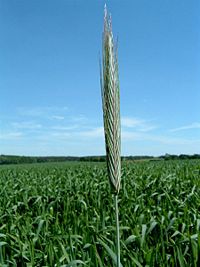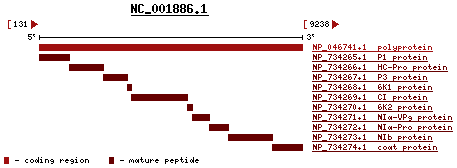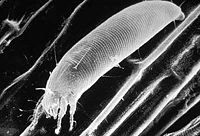Wheat streak mosaic virus: Difference between revisions
imported>Chau Doan mNo edit summary |
imported>Chau Doan mNo edit summary |
||
| Line 37: | Line 37: | ||
==Cell structure== | ==Cell structure== | ||
The virus is in group IV, family Potyviridae, genus Tritimovirus. The virus is simple in structure. The virus has helical capsid. It is naked and doesn't have envelope. The capsid has spiral arrangement in a long tube, about 700 nm in length, and 15nm wide. The single strand RNA is enclosed within the helical capsid. | The virus is in group IV, family Potyviridae, genus Tritimovirus. The virus is simple in structure. The virus has helical capsid. It is naked and doesn't have envelope. The capsid has spiral arrangement in a long tube, about 700 nm in length, and 15nm wide. The single strand RNA is enclosed within the helical capsid. | ||
==Characteristics of wheat cells that are infected with WSMV== | ==Characteristics of wheat cells that are infected with WSMV== | ||
| Line 52: | Line 53: | ||
The virus's favorite natural habitat is wheat. It uses the wheat curl mite as a vector. | The virus's favorite natural habitat is wheat. It uses the wheat curl mite as a vector. | ||
The relation ship between the virus and the wheat is parasitism. The virus takes advantage of the wheat and | The relation ship between the virus and the wheat is parasitism. The virus takes advantage of the wheat and grows at the cost of the wheat's development. | ||
[[Image:The_infection_cycle_of_WSMV.jpg.gif]] | [[Image:The_infection_cycle_of_WSMV.jpg.gif]] | ||
The image above basically summarizes the infection cycle of virus in spring and winter wheat. Winter wheat crop starts to have early infection in the fall. The virus travels along with mites. The mites originate from infected spring wheat crop, volunteer wheat and grass. These mites are carried by the wind to the seeding winter wheat. Young, fresh, seedling wheat are best-loved food of both the mites and the viruses.As time goes on and disease progresses, the winter wheat crop is stunted, yellow, and died prematurely. | |||
The infection in spring wheat depends on the mites that survive from the winter wheat. Infection starts even earlier if the spring crop is grown near the infected winter wheat crop. The volunteer wheat plays an important role between winter and spring wheat crop. Volunteer wheat usually grows in between the young and infected fields. It bears the reservoir of mites and acts as a mean for the mites to jump to the young wheat field nearby. Infected volunteer wheat from winter gives rise to infection in wheat in spring, and infected volunteer wheat in spring crop in turn is responsible for infection of wheat in next fall. | |||
Furthermore, the grass and corn crop nearby are also a reservoir of infection. The mites also can live in these hosts when all the wheat crops have died out. The mites stay in here and leave for the wheat later if the nearby wheat field are seeding and growing. | |||
Beside the wheat, the virus is also indirectly gives a detrimental effect to the human. The wheat infection outbreak due to WSMV has given a great cost of money to the wheat food manufacture industry | |||
==Current Research== | ==Current Research== | ||
| Line 61: | Line 70: | ||
'''Evolution of Wheat Streak Mosaic Virus: Dynamics of Population Growth Within Plants May Explain Limited Variation''' by FRENCH, R.C., STENGER, D.C. | '''"Evolution of Wheat Streak Mosaic Virus: Dynamics of Population Growth Within Plants May Explain Limited Variation"''' by FRENCH, R.C., STENGER, D.C. | ||
This research focuses on the genetic variantion of WSMV and the evolution lineage of viral RNA and WSMV. French and Stenger also have indentified approximately 50 variarions of WSMV. They suggest that the effective virus are much smaller than the actual virus population there are. They also suggest the factors that influence the evolution of WSMV and the patterns of genetic drift during their development | This research focuses on the genetic variantion of WSMV and the evolution lineage of viral RNA and WSMV. French and Stenger also have indentified approximately 50 variarions of WSMV. They suggest that the effective virus are much smaller than the actual virus population there are. They also suggest the factors that influence the evolution of WSMV and the patterns of genetic drift during their development | ||
'''Wheat Streak Mosaic Virus: From Harmful to Helpful''', by Jan Suszkiw | '''"Wheat Streak Mosaic Virus: From Harmful to Helpful"''', by Jan Suszkiw | ||
WSMV has been known as the cause for the loss of wheat industry. The plant pathologist, and his team, takes advantage of the virus as the fact that this virus attacks on the wheat leaves. Stengers’ team use WSMV as a vector to transfer the new genes into the wheat genome and manipulate the wheat for better resistance and crop yield. Using the WSMV in this way is faster and the efficiency of gene transfer in genetic engineer. | WSMV has been known as the cause for the loss of wheat industry. The plant pathologist, and his team, takes advantage of the virus as the fact that this virus attacks on the wheat leaves. Stengers’ team use WSMV as a vector to transfer the new genes into the wheat genome and manipulate the wheat for better resistance and crop yield. Using the WSMV in this way is faster and the efficiency of gene transfer in genetic engineer. | ||
Revision as of 22:47, 29 April 2009
For the course duration, the article is closed to outside editing. Of course you can always leave comments on the discussion page. The anticipated date of course completion is May 21, 2009. One month after that date at the latest, this notice shall be removed. Besides, many other Citizendium articles welcome your collaboration! |
| Wheat Streak Mosaic Virus | ||||||||
|---|---|---|---|---|---|---|---|---|
 | ||||||||
| Virus classification | ||||||||
|
Description and Significance
Wheat Streak Mosaic Virus (WSMV) cannot live and reproduce by itself. WSMV is transferred through wheat curl mite to the crop. This mite is an arthropod. It is so extremely small in size that it cannot be seen with the naked eyes. Overall, the mite serves as a vector for the WSMV to get to the wheat. The wheat is the favorite food source and place to live for both the mite and the WSMV. As the mites reproduce, the WSMV is also passed down to the mites’ progeny. The peak reproduction of mites occurs when the temperature is warmer in spring around 70˚F. Here, the WSMV is also replicated and reproduced progressively as the mites population multiply in number.
{{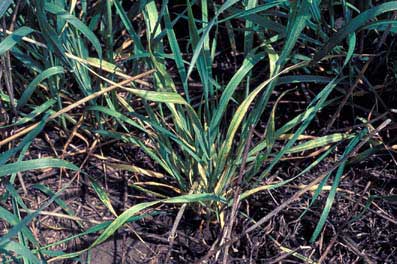 This is an example of an infected wheat.The wheat is stunt, yellow}}
This is an example of an infected wheat.The wheat is stunt, yellow}}
Massive numbers of mites are carried to the wheat field through the wind blow. WSMV from the mites then would infect the wheat. WSMV virus is the cause of the wheat disease. The symptoms resulted from the WSMV infection are very distinct from other virus. The wheat's leaves turn yellowish and have narrow bands. There are blotches on the leaves with different patterns. The normal growth of the wheat is hindered. If the infection is more severe, the leaves can turn completely brown and die off. The total yield of the wheat drops down significantly. If the infection is severe, the loss can be up to 100%.
Distribution
In the US, the WSMV infection is heavily found in the midwest: North Dakota, Kentucky, Michigan, Minnesota and Ohio.The fall and spring wheat field suffer the detrimental effects significantly. Now the virus infection is moderate in control as the scientists understand more about the causes, effects and mechanisms of virus transmission. The most prevalent infection occurred in 1987-1988. Recently, WSMV also found in Virginia in 2000
In the world, according to the data collected by US Department of Agriculture, the other countries that are also known to suffer from WSMV disease are Canada, Jordan, Rumania, Australia, Yugoslavia, Russia.
Genome structure
The WSMV is positive, linear, single-strand RNA (ssRNA). According to the International Committee on Taxonomy of virus, the complete genome of WSMV has 9384 nucleotides. The G+C content is 44%. The % coding is 97%. The sequence only codes for one long polypeptide. This long polypeptide has both structural and non-structural proteins.
In the image provided from pubmed reference page on the left, the long polynucleotide sequence code for 10 proteins: P1 protein, HC-Pro protein, P3 protein, 6K1 protein, CI protein, 6K2 protein, NIα-VP9 protein, NIα-Pro protein, NIb protein and coat protein. So far Hc-Pro gene has been the one that has the greatest number of studies. The researchers knock out the the HC-Pro gene and observe the effects on the virus. Furthermore, there are many different strains of the same WSMV. Some are milder than others.
Cell structure
The virus is in group IV, family Potyviridae, genus Tritimovirus. The virus is simple in structure. The virus has helical capsid. It is naked and doesn't have envelope. The capsid has spiral arrangement in a long tube, about 700 nm in length, and 15nm wide. The single strand RNA is enclosed within the helical capsid.
Characteristics of wheat cells that are infected with WSMV
The wheat cell bears many inclusions in the cytoplasm. The nucleus is distorted in shape. The inclusions do not have any rigid shape. They are varied in appearance. The inclusions are involved with viral proteins. There is an increased reproduction rapidly in number of membranes and ribosome’s. As the infections go on and progress, the cells is twisted out of shape and the organelles are disintergrated
Other possible hosts for WSMV
The virus not only attacks all sorts of wheat but also the other cereal plants. The other cereal plants are oeats, barley, rye, maize, millets and sorghum. Wild grass is also affected. If there cereal plants and wild grass are grown in very close distance to the infected wheat crop, they can catch the mites by wind and develop WSMV soon. However, young wheat is still the number one ranged from the favorite host of mite and WSMV. Mites and WSMV only attack the other cereal plants when the wheat crops are severe damaged, grown old, degraded in nutritional values
How to indentify the wheat infected with WSMV
It’s hard to differentiate the normal, healthy wheat from the early infected wheat that hasn’t had any apparent, visible symptoms yet. Plant pathologists usually use electron microscope or perform Enzyme Linked Immunosorbent Assay test (ELISA). These tests were conducted in the labs by entomologists and plant pathologists. In ELISA test, the sap of infected plants is collected in antivirus serum. The result of the test is then compared with the known sap with WSMV. The more similarities between the reference and unknown sap, the more likely the plant is infected with WSMV.
Ecology
The virus's favorite natural habitat is wheat. It uses the wheat curl mite as a vector.
The relation ship between the virus and the wheat is parasitism. The virus takes advantage of the wheat and grows at the cost of the wheat's development.
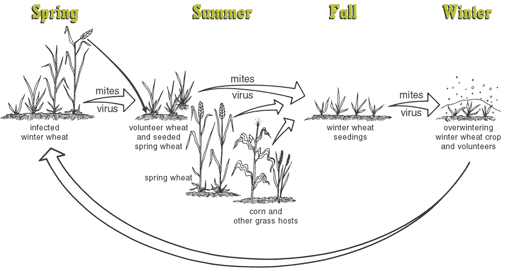
The image above basically summarizes the infection cycle of virus in spring and winter wheat. Winter wheat crop starts to have early infection in the fall. The virus travels along with mites. The mites originate from infected spring wheat crop, volunteer wheat and grass. These mites are carried by the wind to the seeding winter wheat. Young, fresh, seedling wheat are best-loved food of both the mites and the viruses.As time goes on and disease progresses, the winter wheat crop is stunted, yellow, and died prematurely.
The infection in spring wheat depends on the mites that survive from the winter wheat. Infection starts even earlier if the spring crop is grown near the infected winter wheat crop. The volunteer wheat plays an important role between winter and spring wheat crop. Volunteer wheat usually grows in between the young and infected fields. It bears the reservoir of mites and acts as a mean for the mites to jump to the young wheat field nearby. Infected volunteer wheat from winter gives rise to infection in wheat in spring, and infected volunteer wheat in spring crop in turn is responsible for infection of wheat in next fall.
Furthermore, the grass and corn crop nearby are also a reservoir of infection. The mites also can live in these hosts when all the wheat crops have died out. The mites stay in here and leave for the wheat later if the nearby wheat field are seeding and growing. Beside the wheat, the virus is also indirectly gives a detrimental effect to the human. The wheat infection outbreak due to WSMV has given a great cost of money to the wheat food manufacture industry
Current Research
“Complete Deletion of Wheat Streak Mosaic Virus HC-Pro: a Null Mutant Is Viable for Systemic Infection” by Drake C. Stenger, Roy French, and Frederick E. Gildow
In this research, the authors work on a WSMV that doesn’t have HC-Pro. The researchers use the technique in vitro transcription and translation to confirm with the deletion of HC-Pro. The deleted HC-Pro fails to compete with the wild type WSMV. Its reproduction is reduced. This can suggest the possibility to modify WSMV.
"Evolution of Wheat Streak Mosaic Virus: Dynamics of Population Growth Within Plants May Explain Limited Variation" by FRENCH, R.C., STENGER, D.C.
This research focuses on the genetic variantion of WSMV and the evolution lineage of viral RNA and WSMV. French and Stenger also have indentified approximately 50 variarions of WSMV. They suggest that the effective virus are much smaller than the actual virus population there are. They also suggest the factors that influence the evolution of WSMV and the patterns of genetic drift during their development
"Wheat Streak Mosaic Virus: From Harmful to Helpful", by Jan Suszkiw
WSMV has been known as the cause for the loss of wheat industry. The plant pathologist, and his team, takes advantage of the virus as the fact that this virus attacks on the wheat leaves. Stengers’ team use WSMV as a vector to transfer the new genes into the wheat genome and manipulate the wheat for better resistance and crop yield. Using the WSMV in this way is faster and the efficiency of gene transfer in genetic engineer.
Pathology
The WSMV only infects cereal plants and hinder the growth of wheat. It does not infect angiosperms or humans
References
[1]http://www.ncbi.nlm.nih.gov/sites/entrez?Db=gene&Cmd=Search&TermToSearch=NC_001886[accn]
[2]http://www.ncbi.nlm.nih.gov/sutils/gmap.cgi?result=map&acc=NC_001886&organism=2451
[3]http://www.ncbi.nlm.nih.gov/ICTVdb/ICTVdB/00.057.0.06.001.htm
[4]http://www.dpvweb.net/dpv/showdpv.php?dpvno=393
[5]http://en.wikipedia.org/wiki/Wheat_streak_mosaic_virus
[7]http://www.ars.usda.gov/research/publications/publications.htm?seq_no_115=145703
[8]http://findarticles.com/p/articles/mi_m3741/is_12_48/ai_68864545/
